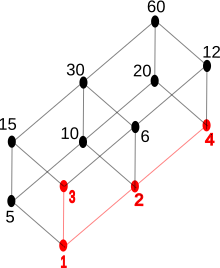
In mathematics, especially in order theory, a maximal element of a subset of some preordered set is an element of that is not smaller than any other element in . A minimal element of a subset of some preordered set is defined dually as an element of that is not greater than any other element in .
The notions of maximal and minimal elements are weaker than those of greatest element and least element which are also known, respectively, as maximum and minimum. The maximum of a subset of a preordered set is an element of which is greater than or equal to any other element of and the minimum of is again defined dually. In the particular case of a partially ordered set, while there can be at most one maximum and at most one minimum there may be multiple maximal or minimal elements.[1][2] Specializing further to totally ordered sets, the notions of maximal element and maximum coincide, and the notions of minimal element and minimum coincide.
As an example, in the collection ordered by containment, the element {d, o} is minimal as it contains no sets in the collection, the element {g, o, a, d} is maximal as there are no sets in the collection which contain it, the element {d, o, g} is neither, and the element {o, a, f} is both minimal and maximal. By contrast, neither a maximum nor a minimum exists for
Zorn's lemma states that every partially ordered set for which every totally ordered subset has an upper bound contains at least one maximal element. This lemma is equivalent to the well-ordering theorem and the axiom of choice[3] and implies major results in other mathematical areas like the Hahn–Banach theorem, the Kirszbraun theorem, Tychonoff's theorem, the existence of a Hamel basis for every vector space, and the existence of an algebraic closure for every field.
- ^ Richmond, Bettina; Richmond, Thomas (2009), A Discrete Transition to Advanced Mathematics, American Mathematical Society, p. 181, ISBN 978-0-8218-4789-3.
- ^ Scott, William Raymond (1987), Group Theory (2nd ed.), Dover, p. 22, ISBN 978-0-486-65377-8
- ^ Jech, Thomas (2008) [originally published in 1973]. The Axiom of Choice. Dover Publications. ISBN 978-0-486-46624-8.



